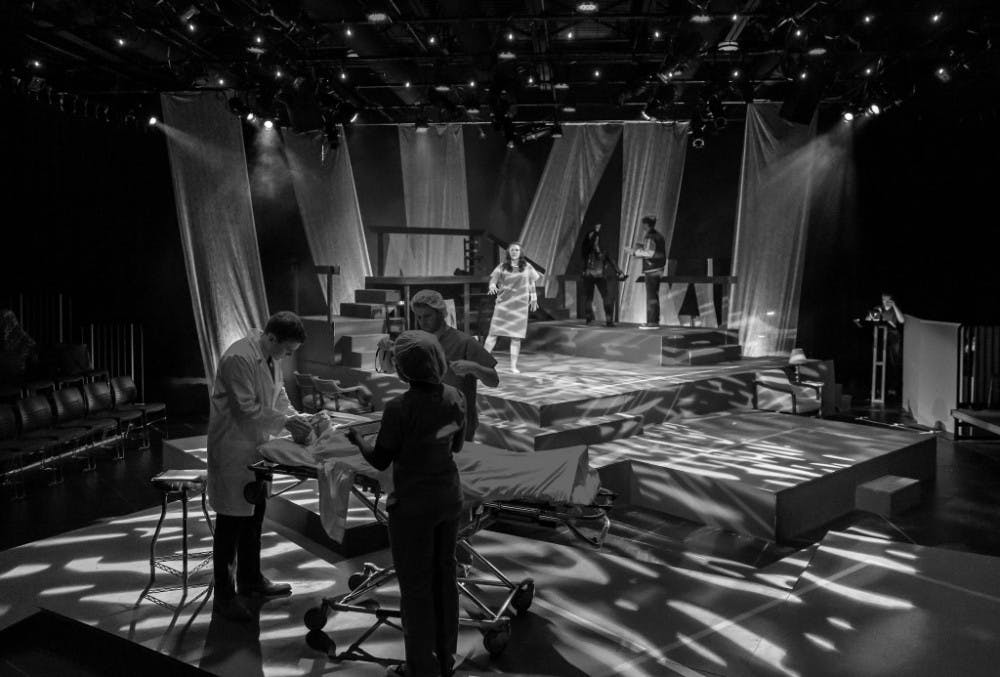Darkness.
A crippled mind. A dysfunctional family. “Next to Normal” brought the struggles of mental illness to life at Elon University April 23 – 26.
The musical deals with themes such as suicide, drug abuse and grieving. The storyline centers on matriarch Diana Goodman, who is suffering from bipolar disorder after the loss of her child.
Linda Sabo, director and associate professor of performing arts, watched the original cast perform a song from the Pulitzer Prize-winning show at the Tony Awards and was immediately intrigued.
“The music is beautifully written, and I thought it would be a challenge for our students because of the contemporary rock sound,” Sabo said.
Elon musical theater majors are primarily classically trained, but with the help of faculty trained in contemporary and rock singing, Sabo said the vocally demanding show was a challenge students were willing and able to take on.
Over the course of two days, 150 students auditioned for the show, singing various pieces from the show and, later in the audition process, songs for specific characters. The show was double cast, with each cast performing three times.
Senior Zach Teague, assistant director, said actors are belting taxing rock ballads for almost the entirety of the show. The decision to double cast the production not only gave students more opportunities to perform but also prevented vocal straining.
“Next To Normal” was performed in Roberts Studio Theatre, one of the newest art facilities on campus. Teague said Roberts Studio Theatre — a black box theater — catered perfectly to “Next to Normal” because of its ability to allow audiences to connect with the characters on a deeper level.
“It is such an intimate space, so the audience is able to catch things that they wouldn’t normally catch in a big theater,” Teague said. “It’s cool because it feels like you’re in it with them and really feeling the strong emotions of the characters.”
The black box is constructed with black sheets hanging on stage and around the theater, which was intended to represent Diana Goodman’s psychological problems by giving audience members the impression they were looking into the “walls” of her mind.
Sabo wanted the show to be as abstract as possible while playing with the black box theater setting. The actors move cinematically through each scene with psychological-based choreography.
“Next to Normal” highlights mental illness, a topic people often avoid for fear of facing stigmas and ignorance from others. Junior Lizzie Markson, who played Natalie Goodman, said she expected the dark themes of the show to be hard to handle but considered working with them an enjoyable and educational process.
“Most of the characters are in such a dark place, but I’ve found that you just have to lose yourself and immerse yourself in the role,” Markson said. “It is definitely emotionally exhausting because it’s so intense, but we try to keep each other laughing to keep us sane.”
As assistant director, Teague helped actors develop their characters and find motivation in their scenes. Watching rehearsals continuously led him and the cast to become more comfortable with the depressing topics in the show.
“We did so much research on electro-shock therapy, grief and mental illness medications,” Teague said. “We wanted to steer the actors in the right direction of handling such an emotionally driven show, but they were already so mentally prepared from day one.”
Markson said playing Natalie gave her the opportunity to explore and express deeper emotions.
“[Teague] has said to me, ‘I wish I could show you a video of yourself from the beginning of rehearsals to now,’” Markson said. “I’m constantly being pushed to take risks.”
Sabo said she was amazed how the cast could understand and perform the material so well, especially the two actors who played Diana, a 40-year-old bipolar woman.
“Each generation gets smarter and more sophisticated at a much earlier age,” Sabo said. “This maturity translates into their acting, and you immediately suspend disbelief, convinced that they are truly going through what the characters are dealing with.”
Although the characters are part of what seems like a normal suburban family, what lies beneath the surface is the overarching theme of the show: the challenges of mental illness.
Sabo hopes this focus will make the audience more educated and aware of mental illness.
“The finale is called ‘Light,’ and I think that encompasses the overall theme of the show,” Sabo said. “You may have to search long and hard, but there is hope at the end of the tunnel.”


